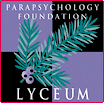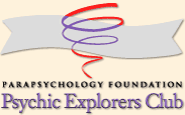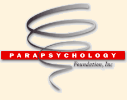 |
 |
| The Reinvigoration and Contemporary Conceptualization of Parapsychology by Emma Stone University of Auckland Parapsychology is a science fraught with challenges, owing to the very nature of the subject matter it endeavours to study and analyse. The “challenges” presented by parapsychology are of a diverse nature and can be examined in a multitude of ways: the logical challenges of re-producing and replicating experiments and data, the methodological challenge of creating experiments that are tightly controlled and approved by the wider scientific community and free of influencing factors that may affect the outcome of the experiment, and on a more philosophical note, the challenge with which parapsychology confronts humanity, asking us to re-consider our modes of seeing and interpreting the world and opening our minds to embracing a new way of comprehending our existence, a way that could be enormously beneficial to our development and evolution on this planet. Like Darwinian evolutionism, and the heliocentric theory presented by Copernicus, scientific discoveries that shake the foundations of human existence, and discard long-held human beliefs about the nature of the world we live in create havoc in society. Deeply embedded beliefs are resistant to change, even in the face of empirical data (Utts, 1991, p. 363). It is this unwillingness in human nature to accept new findings that defy conventional thought that provokes conservative academics to pose challenges to parapsychology, requesting innumerable trial runs and experiments with every conceivable, and indeed, inconceivable control variable, the resulting work so tightly monitored that many scientists are discouraged to engage in parapsychological research in the first place. However, the dedicated and genuine parapsychologists that do persist with research have demonstrated to discontents and sceptics that verifiable, replicable and authentic experiments have been executed numerous times, under rigorous and even neurotic laboratory conditions, producing data that undeniably supports the existence of psi phenomena. This can largely be attributed to developments in the field such as the use of meta-analysis. Parapsychology has always been tightly interwoven with statistics, and meta-analysis permits parapsychologists to synthesize statistically large bodies of work, showing relationships and results that are experimentally far more revealing and meaningful than the analysis of isolated experiments with limited trial runs. Although accurate data analysis methodology, unassailable experimental design and the replication of results are still ongoing challenges for parapsychology, they have been long recognised as issues. Reinforced methodology has been constructed in order to process psi data in a way satisfactory to the sceptical scientific sphere. Therefore this essay will attempt to demonstrate that there are presently other more contemporary challenges to parapsychology that have not been as thoroughly considered and which merit study. The first challenge that will be discussed is the reconciliation and unification of parapsychology with other disciplines such as quantum physics, or reinforcing parapsychological findings in an interdisciplinary sense. In recent years, a plethora of literature has emerged concerning quantum physics and its presence and influence in every day life. Many of these books that relate the significance of the new influx of research reveal the existence of incredible theories, such as super-string theory. A vast amount of recent quantum physics findings hold huge relevance for parapsychology, as they provide a potential means for scientifically explaining the possible cause of psi phenomena, therefore giving scientific weight to psi research. Dean I. Radin’s (1997) The Conscious Universe: the Scientific Truth of Psychic Phenomena discusses psi research and findings rationalised by quantum physics, as does fellow parapsychology researcher Diane Hennacy Powell. For example, super-string theory asserts that the universe consists of inter-connected vibrating 1-dimensional objects with tension and length, and that the vibrations of these 1-dimensional objects affect the vibrations of the 1-dimensional objects around them. The interconnectedness of the universe stressed by this theory could be researched and possibly related to results in psi experiments such as those testing for telepathy or clairvoyance (pp.). One respected academic who has also made this connection in creating an interdisciplinary form of parapsychology with more conventional science is Rupert Sheldrake, whose recent book The Sense of Being Stared At gives examples of quantum physics theory and even evolutionary biology to account for certain psi phenomena, such as being stared at. He offers a way of scientifically rationalising psi phenomena that would otherwise be unacceptable or unbelievable to sceptical people. In the opening chapters of The Sense of Being Stared At, Sheldrake asserts that considerable statistical proof exists to support the claim that people can sense when they are being stared at without visually detecting it, and then goes on to hypothesize that this super sensory knowledge could be an evolutionary mechanism that has evolved in animals which are preyed upon, as those animals with extrasensory awareness are able to sense when a predator or threat is watching them, and thus escape. Therefore these animals are more likely to reproduce and pass on this trait for super sensory awareness to their offspring. This biological explanation for a “paranormal” phenomena integrates valid aspects of both parapsychological science and biological science, and helps contribute towards grounding parapsychology more in conventional science, so it is not seen so much as an unscientific offshoot of psychology. The challenge of finding ways to combine parapsychological research with other sciences is a challenge with potentially advantageous outcomes in helping psi research become more respected and acknowledged in the mainstream. Another challenge facing parapsychology is of a more conventional nature. It involves the issue of experiments testing for psi that involve research matter which is of little significance or interest to the human participant in the experiment. This has been clearly illustrated in the classic parapsychology experiments carried out by J. B. Rhine on subject Adam Linzmayer using Zener cards. Linzmayer’s success was statistically above average in the first test (39.6% correct scores, when chance would have been only 20%), and highly in the next series of tests, but over time, his success began to decline (Koestler, 1972). This effect has been observed in numerous experiments testing for psi phenomena. When researchers repeat the experiment multiple times, searching for consistent, quantifiable and replicable results, the success rate often dwindles. This has been attributed to the fact that the experiment which is initially engaging and exciting, becomes boring and repetitive and ultimately holds little relevance to the participant. Many persons who claim to have had telepathic or clairvoyant experiences also stress that the experiences occur anomalously, and usually have some personal significance for them. Elizabeth Lloyd Mayer’s contemporary research into anomalous cognition affirms these declarations. This therefore creates an experimental dilemma, as the very nature of the phenomena that is being studied cannot always be produced on demand, at will, or in a sterile laboratory setting. However, conventional scientific practice demands that experiments attempting to demonstrate the existence of psi phenomena do this. Therefore, this is another huge challenge which parapsychology must address and overcome: creating an experimental model which can test for psi in conditions conducive to psi, but also in a scientific setting and following a methodology acceptable to the wider scientific community. Finally, a third challenge of parapsychology is in the current conceptualization and understanding of the subject itself. For a very long time, certain parapsychological precepts have been unquestioned and taken for granted. For example, in most parapsychological experiments and tests involving telepathy, it is the role of the receiver that is more carefully monitored and analyzed than the role of the sender. What if everybody has a mind equally capable of receiving telepathic messages, and it is the intention and desire of the sender to send the message that is most significant in the outcome of the experiment? What if an experiment were conducted where an isolated receiver was asked to try and receive messages consecutively (but with a break between trials) from a panel of 10 different senders, some of whom claim to have telepathic abilities and others who claim not to? More research into the active aspects of parapsychology rather than continued research into passive reception could reveal a multitude of new findings, and help ensure that parapsychology does not stagnate, and that long-accepted precepts are constantly challenged and tested. In conclusion, the challenge of parapsychology permeates and hinders its dissemination into the mainstream, but therefore also means that it remains an extremely unique branch of science. Parapsychology demonstrates that the nature of science itself (with which humanity has for too long been comfortably familiar) needs to be itself challenged. The logic, rationalism, replicable results and laboratory settings which characterize modern science somewhat detract from the true essence of scientific phenomena, and parapsychology challenges us by forcing us to think outside that scientific square. Parapsychology itself is challenged to maintain its mysterious and elusive scientific integrity whilst conforming somewhat to the experimental boundaries established by conventional science, and parapsychologists are challenged to continue re-conceptualizing and finding new and organic ways to study and explain psi phenomena. Bauer, E. (1984). Criticism and controversy in parapsychology: An overview. European Journal of Psychology, 5, 141-146. Kennedy, J.E. (2004). A proposal and challenge for proponents and skeptics of psi. Journal of Parapsychology, 68, 157-167. Koestler, A. (1972). The roots of coincidence. London: Hutchinson. Mayer, E. L. (2007). Extraordinary knowing: Science, skepticism and the inexplicable powers of the human mind. New York: Bantam Books. Powell, D. H. (2009). The ESP enigma: The scientific case for psychic phenomena. New York: Walker. Radin, D. I. (1997). The conscious universe: The scientific truth of psychic phenomena. New York: Edge. Utts, J. (1991). Replication and meta-analysis in parapsychology. Statistical Science, 6(4), 363-403. |
 |

|
 www. parapsychology. org |
||